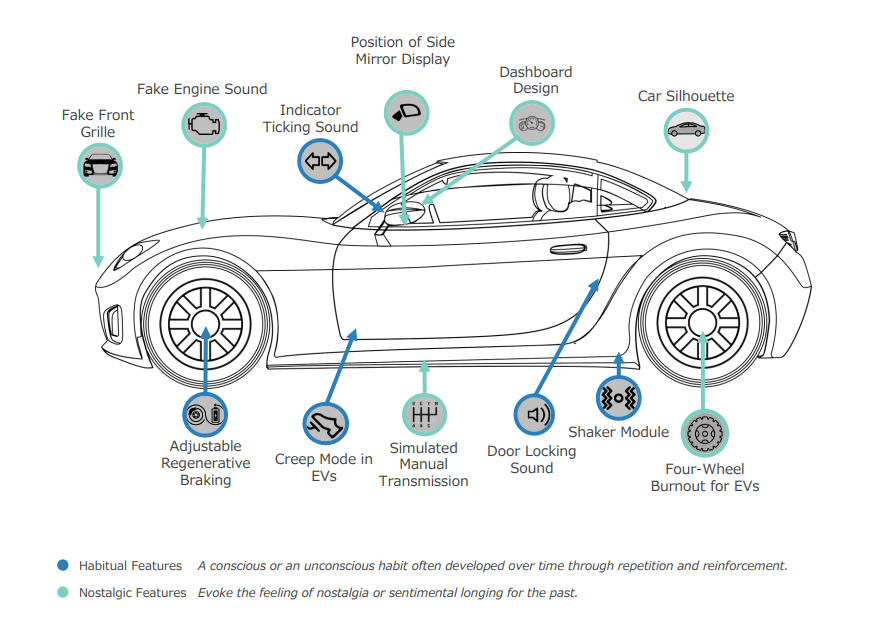
As the automotive industry shifts towards electric vehicles, manufacturers are incorporating habitual and nostalgic features from traditional vehicles to ease the transition for customers.
These features are not only meant to provide a sense of familiarity but also to create emotional linkage and enhance driver engagement.
Although the concept of these features will remain in the future, the features themselves could change over time as these features could become obsolete or be replaced by other features eventually.
What is happening?
OEMs are developing more and more habitual and nostalgic features and functions for upcoming EVs.
Habitual and nostalgic features can provide new EV users with a sense of familiarity from ICE vehicle features.
Habitual and nostalgic features have been around for a while with OEMs using them to bring in customers into new generations of vehicles.
Here are some examples of OEMs helping to bring in the Electric Vehicle generation: Lexus’ simulated manual transmission, indicator ticking sound and Ford’s EV-tailored four-wheel drive burnout.

Why does it matter?
EV market is growing quickly, and the habitual & nostalgic features could act as a catalyst to increase the acceptance of EVs among early and late majorities.

Earlier EV adopters may favor new, unique features, while laggards will have a stronger need for familiarity.
Habitual features will help OEMs to now target the early and late majority with EVs.
Nostalgic features could also help late majority and laggards adopt EVs.
Some novel, cutting-edge features may eventually become habitual features over time.
Some cutting-edge features will be withdrawn due to customer's unwillingness to accept them. This could lead to bringing back a feature that was previously replaced, for example, the Tesla yoke steering wheel.
Where next?
Habitual EV features may, in time, begin being phased out. Autonomous Vehicles and Shared Mobility will lead to new Habitual and Nostalgic features.
The fake front grille will likely be phased out as people get used to the “new” way. Features like fake engine sound, are likely to stay in some models, such as performance models.
Instrument cluster will likely be replaced by AR and HUD systems, perhaps with nostalgic elements. This shows that some familiar features will be replaced by a more advanced version of the same.
Cutting edge Autonomous Vehicle features will initially appeal, but majority adoption will utilize habitual features. In time, nostalgic AV features may appeal.
Shared mobility has a particular opportunity for habitual features, due to the varied model usage by users.

To ease the transition of new customers from ICEs to EVs, OEMs will introduce more habitual features for the faster adoption of EVs.
To improve the acceptance of EVs by the late majority and laggards, OEMs may have to introduce nostalgic features.
Some OEMs will experiment with cutting-edge features which would potentially replace the existing habitual features.
Cutting-edge features that gain acceptance will turn out to be the 'new' familiar features which will facilitate in the transition from EVs to its advanced forms of transportation.
What to watch out for?
Watch out for the hygiene features moving to delight and performance, and cutting-edge features becoming hygiene features.

As time goes by cutting edge features lose their attractiveness due the natural decay of delight. These features turn into either performance or hygiene features.
Features like a front grille or gear box have moved from hygiene to delighting on EVs as nostalgia, but they may not stick around.
We shall see OEMs introducing and removing features depending upon the EV lifecycle, and which level of adopter they are targeting.
Some OEMs will over-reach and need to ‘back-pedal’ and some will mistime their product timelines.
How should you react?
Observe
Observe how well these features help in the transition to EVs compared to its cost of development. Toyota, Tesla and Ford are the leaders in bringing familiar features into EVs.
Invest
Invest in research to identify which familiar features are more important to customers and how to effectively simulate them into new energy vehicles without compromising performance or safety.
Create
Create new unique cutting-edge features which have the potential to transfer from "attractive" to "must be" and to become new familiar features.
Interested in finding out more?
Most of our work is helping clients go deeper into new challenges and opportunities through custom projects. If you would like to discuss recent projects we've completed relating to infotainment, contact us today!
Also, be sure to view our related content:


